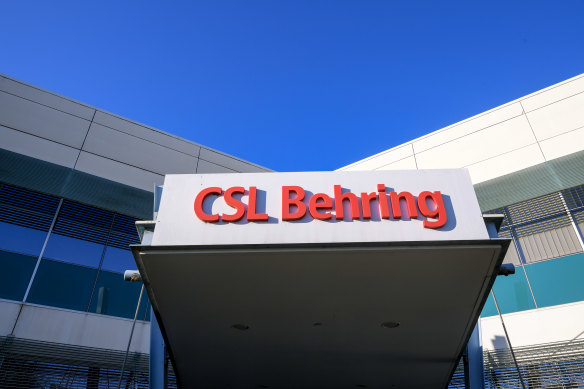Plasma’s back: Boost for CSL as collections troubles ease
By Emma Koehn
Australia’s largest biotech CSL is in a strong position on blood plasma collections after years of damaging COVID interruptions as the company looks beyond the pandemic to new treatment areas and products for growth.
Outgoing CSL boss Paul Perreault told investors on Tuesday that the healthcare giant had an impressive jump in plasma volumes of 36 per cent during the first half of 2023. This had helped fuel sales growth of 19 per cent across the company’s core portfolio of specialist medicines that use plasma to treat diseases such as hereditary angioedema.

Human blood plasma is collected via donors, largely in the US, and refined to make CSL’s suite of specialist medicines. COVID-19 lockdowns and restrictions had constrained volumes of plasma over the past few years, leading to less product to sell.
Donors in the US receive a fee, usually starting at about $US50, each time they donate plasma. Those fees have remained elevated after lockdowns as CSL and its competitors try to get participants into collection centres, which has meant elevated costs across the business.
“Am I happy? There’s more work to do – [but] I do see collections continuing to go up,” Perreault said.
“I think we’re in good shape. It’s just a constant, diligent effort by a whole lot of people to make this happen.”
The company reported half-year profits on Tuesday that were steady at $US1.6 billion ($2.3 billion) in “constant currency” terms, or when the impact of foreign currency fluctuations are disregarded. That was an 8 per cent fall on last year due to acquisition costs for the takeover of Swiss pharma firm Vifor and continued elevated costs for plasma collections but Perreault and his successor, Paul McKenzie, were focused on the long-term growth plan.
“We have a great game plan, and Paul [McKenzie] understands the game plan,” Perreault said.
CSL reaffirmed its full-year guidance of profits between $US2.7 billion and $2.8 billion. Total revenue leapt by 25 per cent to $US7.6 billion in constant currency terms. That includes $US923 million in revenue from iron deficiency and kidney disease treatments maker Vifor, which CSL acquired last year for $16.4 billion.
‘I think we’re in good shape. It’s just a constant, diligent effort by a whole lot of people to make this happen.’
Paul Perreault, outgoing CSL chief executive
Many of the challenges CSL faced during the first years of the COVID-19 pandemic are now in the rearview mirror, allowing incoming chief executive Paul McKenzie to focus on the continued integration of Vifor into the CSL business, as well as the growth of new products including CSL’s gene therapy for haemophilia B patients, which was recently approved for use in the US.
Perreault said the gene therapy would not make billions for CSL, but could generate hundreds of millions of dollars over time. The launch of the product, which is designed to help patients by replacing regular infusions of medicine across their lifetimes with a one-off treatment, was a significant milestone for the company and a career highlight, he said.
“For little CSL, who left Australia to globalise and become the player we are today, for us to be at the forefront and in the limelight, in the spotlight for the first gene therapy for something that’s more than just an ultra, ultra-rare disease, is unbelievable,” he said.
“It’s just a phenomenal thing to see in your career.”
S&P Global Ratings said CSL’s update indicated its path to reducing debt remained on track after its Vifor purchase last year.
“Additional earnings contributions from recently acquired CSL Vifor and solid performance from CSL’s influenza business, Seqirus, are also helping to improve credit metrics,” the group said on Tuesday.
CSL declared an interim dividend of $US1.07 a share, a 3 per cent rise on the same time last year, to be paid on April 4.
The company’s shares had rallied in the weeks leading up to half-year earnings, and closed 0.9 per cent higher on Tuesday to $307.75. The stock is up by 9 per cent year-to-date.
The Market Recap newsletter is a wrap of the day’s trading. Get it each weekday afternoon.
Most Viewed in Business
Source: Thanks smh.com